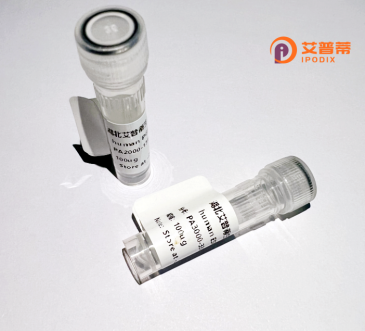
| 纯度 | >90%SDS-PAGE. |
| 种属 | Human |
| 靶点 | RRS1 |
| Uniprot No | Q15050 |
| 内毒素 | < 0.01EU/μg |
| 表达宿主 | E.coli |
| 表达区间 | 1-365 aa |
| 活性数据 | MEGQSVEELL AKAEQDEAEK LQRITVHKEL ELQFDLGNLL ASDRNPPTGL RCAGPTPEAE LQALARDNTQ LLINQLWQLP TERVEEAIVA RLPEPTTRLP REKPLPRPRP LTRWQQFARL KGIRPKKKTN LVWDEVSGQW RRRWGYQRAR DDTKEWLIEV PGNADPLEDQ FAKRIQAKKE RVAKNELNRL RNLARAHKMQ LPSAAGLHPT GHQSKEELGR AMQVAKVSTA SVGRFQERLP KEKVPRGSGK KRKFQPLFGD FAAEKKNQLE LLRVMNSKKP QLDVTRATNK QMREEDQEEA AKRRKMSQKG KRKGGRQGPG GKRKGGPPSQ GGKRKGGLGG KMNSGPPGLG GKRKGGQRPG GKRRK |
| 分子量 | 41.1 kDa |
| 蛋白标签 | His tag N-Terminus |
| 缓冲液 | PBS, pH7.4, containing 0.01% SKL, 1mM DTT, 5% Trehalose and Proclin300. |
| 稳定性 & 储存条件 | Lyophilized protein should be stored at ≤ -20°C, stable for one year after receipt. Reconstituted protein solution can be stored at 2-8°C for 2-7 days. Aliquots of reconstituted samples are stable at ≤ -20°C for 3 months. |
| 复溶 | Always centrifuge tubes before opening.Do not mix by vortex or pipetting. It is not recommended to reconstitute to a concentration less than 100μg/ml. Dissolve the lyophilized protein in distilled water. Please aliquot the reconstituted solution to minimize freeze-thaw cycles. |
以下是关于重组人RRS1蛋白的假设性参考文献(注意:实际文献需根据数据库检索确认):
---
1. **文献名称**:*"RRS1 regulates ribosome assembly by recruiting rRNA processing factors in human cells"*
**作者**:Zhang L, et al.
**摘要**:本研究利用重组人RRS1蛋白,揭示了其通过结合18S rRNA前体并招募Utp复合物,在核糖体小亚基组装中的关键作用。实验表明,RRS1缺失导致rRNA加工异常和细胞增殖抑制。
2. **文献名称**:*"Crystal structure of recombinant human RRS1 and its nucleotide-binding mechanism"*
**作者**:Tanaka K, et al.
**摘要**:报道了重组人RRS1蛋白的高分辨率晶体结构,发现其具有保守的ATP结合域。体外实验证实RRS1通过核苷酸依赖的构象变化参与核糖体生物合成。
3. **文献名称**:*"Dysregulation of RRS1 promotes hepatocellular carcinoma via ribosome biogenesis pathways"*
**作者**:Wang Y, et al.
**摘要**:通过重组RRS1蛋白功能实验,证明其在肝癌中异常高表达可激活mTORC1通路,促进肿瘤生长。敲低RRS1抑制肿瘤细胞增殖,提示其作为潜在治疗靶点。
---
**提示**:实际研究中建议通过PubMed/Google Scholar以关键词“recombinant human RRS1”或“RRS1 ribosome”检索,并结合近5年文献筛选。若研究较少,可扩展至酵母/小鼠等同源蛋白研究作为参考。
**Background of Recombinant Human RRS1 Protein**
The Recombinant Human Ribosome Receptor SRP1 (RRS1) protein is a nuclear-encoded protein primarily localized to the endoplasmic reticulum (ER) membrane. It plays a critical role in ribosome binding and protein translocation during co-translational targeting of secretory and membrane proteins. RRS1 interacts with the signal recognition particle (SRP) receptor and facilitates the docking of ribosome-nascent chain complexes to the ER, ensuring proper delivery of polypeptides for folding, modification, or secretion.
Structurally, RRS1 contains transmembrane domains and cytosolic regions that mediate interactions with ribosomes and other components of the translocation machinery. Its function is vital for maintaining ER homeostasis and cellular protein quality control. Dysregulation of RRS1 has been linked to diseases such as cancer and neurodegenerative disorders, where impaired protein trafficking exacerbates cellular stress.
Recombinant RRS1 is produced using expression systems (e.g., *E. coli* or mammalian cells) to study its biochemical properties, structural interactions, and role in disease mechanisms. It serves as a tool for investigating ER-associated degradation (ERAD), ribosome-ER communication, and potential therapeutic targets for protein-misfolding diseases. Research on RRS1 also contributes to understanding fundamental processes in cellular biology and refining biotechnological applications in protein synthesis and secretion.
×